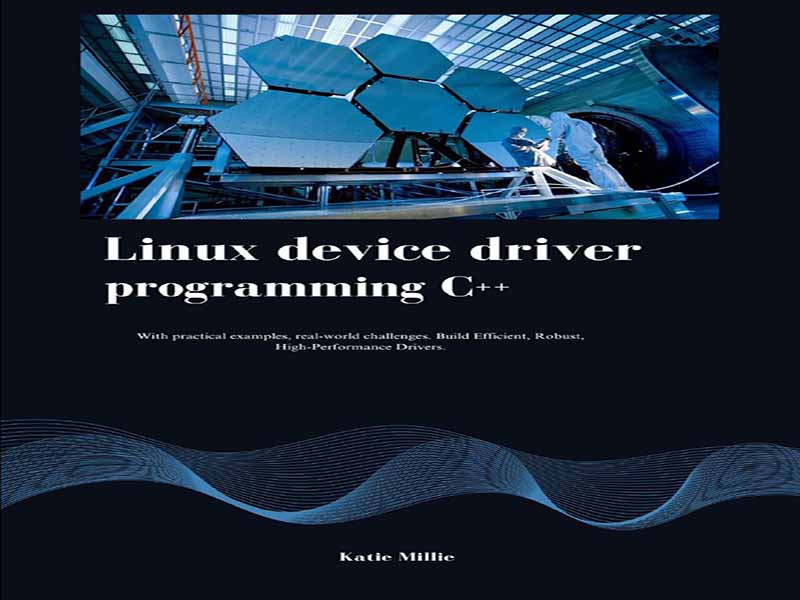- عنوان کتاب: Linux device driver programming C++ – With practical examples, real-world challenges. Build Efficient, Robust, High-Performance
- نویسنده: Katie Millie
- حوزه: برنامه نویسی سیستمی
- سال انتشار: 2024
- تعداد صفحه: 336
- زبان اصلی: انگلیسی
- نوع فایل: pdf
- حجم فایل: 16.2 مگابایت
توسعه هسته، هنر پیچیده ساخت هسته یک سیستم عامل، جذابیت غیرقابل انکاری برای بسیاری از برنامهنویسان دارد. این عرصهای است که در آن عملکرد بسیار مهم است، جایی که هر خط کد بر ضربان قلب سیستم تأثیر میگذارد و پتانسیل شکلدهی به چشمانداز دیجیتال بسیار زیاد است. در حالی که لینوکس به طور سنتی یک دژ C بوده است، ادغام عناصر C++ به تدریج چشمانداز توسعه هسته را تغییر میدهد. قبل از پرداختن به جذابیت آن، درک نقش هسته ضروری است. اساساً، هسته واسطه بین سختافزار و برنامههای کاربر است. منابع سیستم را مدیریت میکند، وقفهها را مدیریت میکند و یک رابط استاندارد برای تعامل برنامهها با سیستم فراهم میکند. برای درایورهای دستگاه، هسته پلی است که پیچیدگیهای سختافزار را با دنیای نرمافزار متصل میکند. یکی از جذابیتهای اصلی، فرصت کار در قلب سیستم است. توسعهدهندگان هسته مانند جراحانی هستند که با دقت روی هسته سیستم کار میکنند. این تعامل صمیمانه با سختافزار، دنیایی از قدرت محاسباتی خام را آشکار میکند که عاری از انتزاعات و سربارهای زبانهای سطح بالاتر است. این حوزهای است که در آن هر چرخه اهمیت دارد و بهینهسازی به یک وسواس تبدیل میشود. درایورهای دستگاه، ارکان اصلی دسترسی به سختافزار برای سیستم هستند. نوشتن درایورهای دستگاه به زبان ++C ترکیبی منحصر به فرد از عملکرد و انتزاع را ارائه میدهد. در حالی که کارایی C غیرقابل انکار است، ویژگیهای شیگرایی ++C میتواند توسعه درایور را، به ویژه برای دستگاههای پیچیده، ساده کند.
Kernel development, the arcane art of crafting the core of an operating system, holds an undeniable allure for many programmers. It’s a realm where performance is paramount, where every line of code impacts the system’s heartbeat, and where the potential to shape the digital landscape is immense. While Linux has traditionally been a C stronghold, the integration of C++ elements is gradually reshaping the kernel development landscape. Before delving into the allure, it’s essential to grasp the kernel’s role. Essentially, it’s the intermediary between the hardware and user applications. It manages system resources, handles interrupts, and provides a standardized interface for applications to interact with the system. For device drivers, the kernel is the bridge connecting the hardware’s intricacies with the software world. One of the primary draws is the opportunity to work at the heart of the system. Kernel developers are akin to surgeons,meticulously operating on the system’s core. This intimate interaction with hardware unveils a world of raw computing power, devoid of the abstractions and overheads of higher-level languages. It’s a realm where every cycle counts, and optimization becomes an obsession. Device drivers are the linchpins that make hardware accessible to the system. Writing device drivers in C++ offers a unique blend of performance and abstraction. While C’s efficiency is undeniable, C++’s object-oriented features can streamline driver development, especially for complex devices.
این کتاب را میتوانید از لینک زیر بصورت رایگان دانلود کنید:
Download: Linux device driver programming C++



































نظرات کاربران